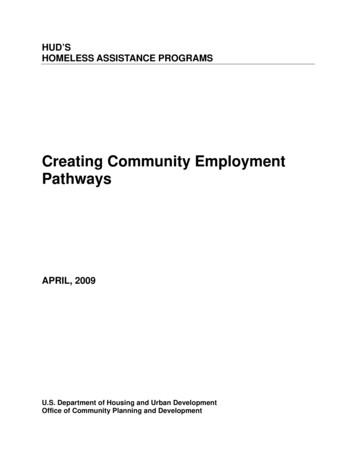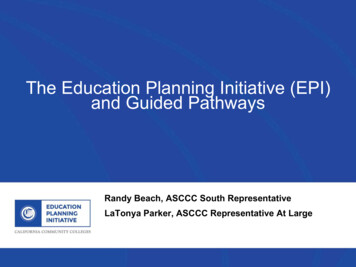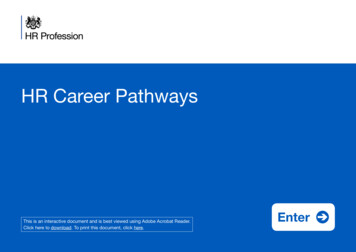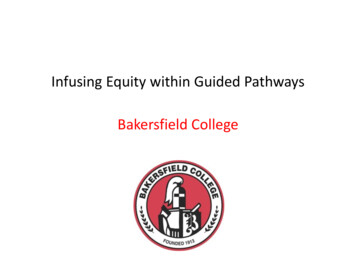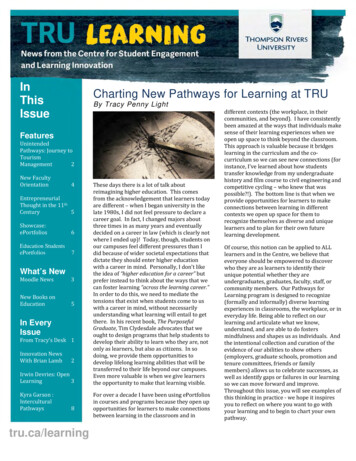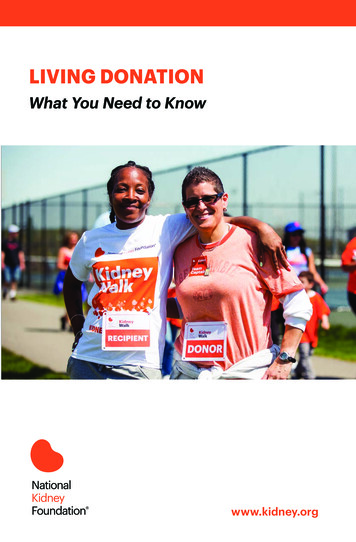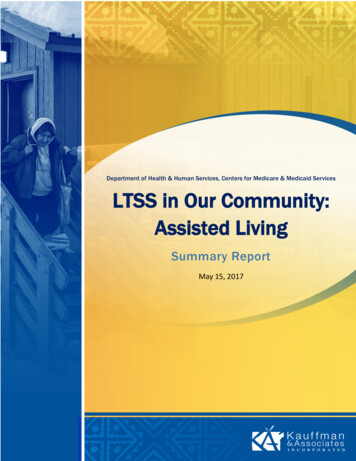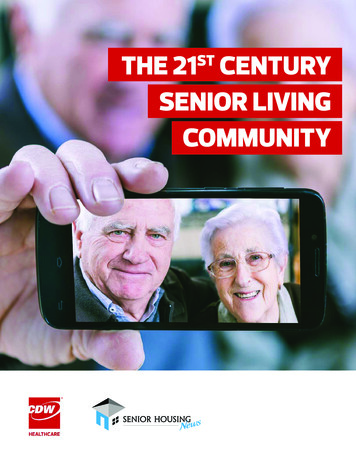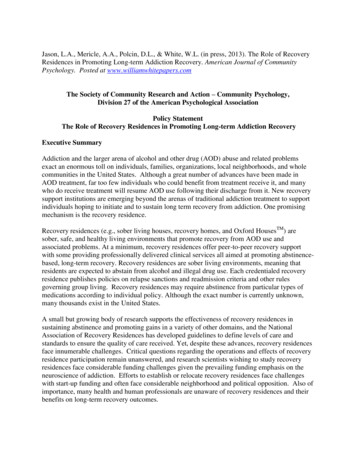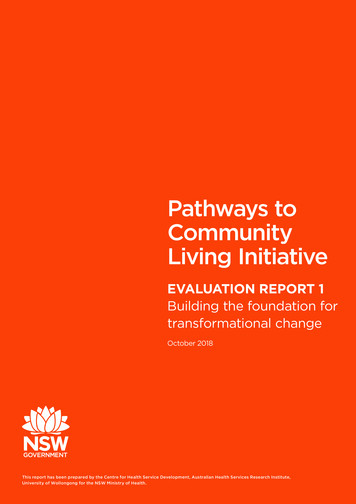
Transcription
Pathways toCommunityLiving InitiativeEVALUATION REPORT 1Building the foundation fortransformational changeOctober 2018This report has been prepared by the Centre for Health Service Development, Australian Health Services Research Institute,University of Wollongong for the NSW Ministry of Health.NSW Health Pathways to Community Living Initiative: Evaluation Report 1i
NSW Ministry of Health73 Miller StreetNORTH SYDNEY NSW 2060Tel. (02) 9391 9000Fax. (02) 9391 9101TTY. (02) 9391 9900www.health.nsw.gov.auThis work is copyright. It may be reproduced in whole or inpart for study or training purposes subject to the inclusionof an acknowledgement of the source. It may not bereproduced for commercial usage or sale. Reproduction forpurposes other than those indicated above requires writtenpermission from the NSW Ministry of Health.Suggested citation:Thompson C, Williams K and Masso M (2018) Pathways toCommunity Living Initiative – Evaluation Report 1:– Buildingthe foundation for transformational change. Centre forHealth Service Development, Australian Health ServicesResearch Institute, University of Wollongong, Wollongong.The NSW Ministry of Health acknowledges the traditionalcustodians of the lands across NSW. We acknowledge thatwe live and work on Aboriginal lands. We pay our respectsto Elders past and present and to all Aboriginal people. NSW Ministry of Health 2019SHPN (MH) 190242ISBN 978-1-76081-131-3Further copies of this document can be downloaded fromthe NSW Health website www.health.nsw.gov.auApril 2019iiPathways to Community Living Initiative: Evaluation Report 1NSW Health
PrefaceFrom NSW Ministryof HealthThis is the first of several reports of the four-yearindependent evaluation of the Pathways toCommunity Living Initiative (PCLI) by the Centrefor Health Service Development, Australian HealthServices Research Institute, University of Wollongong.Established by the NSW Government in 2014/15 thePCLI builds on the work that Local Health Districts(LHDs), consumers, carers and advocacy groupshave been undertaking for many years. Theseefforts have been about improving practice inhealth care settings (both hospital and communitybased) to enable people with Severe and PersistentMental Illness (SPMI) who have long hospital staysto live meaningful lives in the community.What the PCLI provides is an opportunityto extend and build upon this work. It aims to: facilitate the transition of long-stay patients(over 365 days) in our hospitals to moveto the community, including the developmentof appropriate services, and support practice change to decrease thenumber and length of long-stay admissions.This preface is written by the NSW Ministryof Health who commissioned the evaluation.It is an introduction to the wider evaluation, andto this first report. It highlights the main findingsand the recommendations and briefly notes howthese will be monitored for progress.Purpose of PCLI Evaluation Report 1This report outlines the scale of effort andinvestment in the establishment and initial threeyears (mid-2014 to December 2016) of the PCLIboth at LHD and Ministry levels. It is intendedas information for staff, consumers, familiesand carers and the broader public.The PCLI: buildingon concurrent andprevious workThe PCLI does not sit in isolation. No ‘new’developments ever do. It could not occur withoutwhat has gone before or continue without theongoing engagement of the mental healthworkforce, consumers, families and carers.These previous influences include, the: gradual downsizing of bigger hospital sitesover the years hence co-location of non-acute and acute mentalhealth inpatient services with general acutehospitals, and significant advocacy work by consumers,families and carers and the NSW Ombudsmanand the Mental Health Commission of NSW.The PCLI is built on transformation processesat the larger hospital sites including Macquarie,Bloomfield, Cumberland, Kenmore and Morisset.It is growing alongside developments in theNational Disability Insurance Scheme (NDIS).It is also predicated on programs that now forma foundation for work with people with complexmental illness. Examples of this are the NSW HealthHousing and Accommodation Support Initiative(HASI) program and the Ministry of Health OlderPeople’s Mental Health (OPMH) program.In June 2014, NSW had the highest numberof long-stay patients in Australia at around 380.While change had occurred and was progressing,there was a need for greater leadership at a Statelevel in collaboration with LHDs to address thislevel of institutionalised care.Commissioningof the evaluationAt the start of the PCLI the NSW Governmentfunded the commissioning of a high-gradequantitative and qualitative independent evaluationincluding formative and summative components.The purpose was to assess the extent to which thePCLI is meeting its aims, identify opportunities forrefinement, and to inform future investment andpractice change.A key objective was to enable continual feedbackand reflection as the program developed. Evidencefrom similar work overseas shows that wherede-institutionalisation is stalling (or number of longstays increasing), is where reflective practice is notbeing progressed. The evaluation at this high-gradewas also envisaged as placing this work by the NSWGovernment on the international research agenda,adding value to the evidence base for transitioningpeople to community care.The Ministry conducted a competitive Australiawide tender process and the evaluation wasawarded to the Australian Health ServicesResearch Institute, University of Wollongongunder the leadership of Professor Kathy Eagar. early changes in institutional care arising fromthe 1983 Richmond Report and national inquiriesNSW HealthPathways to Community Living Initiative: Evaluation Report 1iii
Main findings andrecommendationsof Evaluation Report 1This report provides a reference point forsubsequent reports. It details the preliminaryplanning, context, history, and early stagesof program development and implementation.The evaluators note that the PCLI has ‘spotlighted’at a system-wide level the needs of a group ofpeople who are still experiencing long periodsof institutionalisation. It is seen as renewinga focus on this group and their rights and desiresfor self-determination. The PCLI is establishingrobust systems to address the support needsof these people and enable them (in many cases)to achieve a life outside hospital for the first timein years.It is emphasised that to further build systemchange and transform people’s lives, requiressustained energy, vision and commitment.The report recommends that the NSW Ministryof Health and collaborating LHDs: Continue to foster the distributed leadershipmodel over the ensuing years Renew the Communication Plan to extend thereach and reflect the stage of PCLI development Assist stakeholders to understand the natureof evaluation and to be involved Influence change through consistent messaging,evidence of success and program adaptationsin response to unforeseen challenges andstakeholder feedback Sustain current approaches to consumerand carer engagement Support LHDs to further build recoveryfocused practice in front-line staff.Since the period of this report many of theseissues have been addressed as the PCLI hasdeveloped. All issues raised in the report will befollowed up and monitored for progress throughthe PCLI Steering Committee. Renewing thecommunication strategy is a key project for 2019.Further information about the ongoing evaluationand the findings detailed in subsequent reportswill be disseminated to key stakeholder groupsthroughout the initiative’s implementation.We have made significant progress. However, thereis still much to be done to build a mental healthsystem where we all accept, using the words of thePCLI consumer lead, that ‘a hospital is not a home’,and work collaboratively to achieve sustainableimprovements in mental health service delivery.ivPathways to Community Living Initiative: Evaluation Report 1NSW Health
Pathways toCommunityLiving InitiativeEVALUATION REPORT 1Building the foundation fortransformational changeOctober 2018Version 4.0NSW HealthPathways to Community Living Initiative: Evaluation Report 1v
viPathways to Community Living Initiative: Evaluation Report 1NSW Health
Acknowledgements:The authors acknowledge the mental health professionals, consumers and families that have contributedto resources produced throughout the Pathways to Community Living Initiative, as these documents haveinformed the development of this report.We particularly acknowledge the lived experience of people with a mental illness; your preferences,wishes, needs and aspirations are at the heart of this program, your perspective is essential to definingand achieving the goals of the Pathways to Community Living Initiative.We would also like to thank staff from the funding body, the Ministry PCLI team and wider Mental HealthBranch, NSW Ministry of Health, for their enthusiasm, assistance and ongoing commitment to thisevaluation.Suggested citation:Thompson C, Williams K and Masso M (2018) Pathways to Community Living Initiative –Evaluation Report 1:– Building the foundation for transformational change. Centre for HealthService Development, Australian Health Services Research Institute, University of Wollongong,Wollongong.NSW HealthPathways to Community Living Initiative: Evaluation Report 11
ContentsExecutive Summary14Background101.1 Introduction101.2 Purpose and scope of this report101.3 Methods101.4 Planning for transformational change103The Implementation Journey273.1 Project/program processes273.1.1 Governance and leadership273.1.2 Communication mechanisms303.1.3 Change and innovation management323.1.4 Workforce development333.2 Getting to know you341.5 Overview of the Pathwaysto Community Living Initiative3.2.1 Individual planning and assessment35113.2.2 Pre and post transition371.5.1 Philosophy and vision113.2.3 Transitions to community living381.5.2 Aims of the PCLI111.5.3 Structure of the program1.5.4 NSW Treasury KeyPerformance Indicators121.6 Mental health policy and servicedelivery environment3.3 Service development1213393.3.1 Modelling393.3.2 Enhancements and tenders393.3.3 Partnerships403.4 Information and evaluation411.6.1 Policy context133.4.1 PCLI Program Logic411.6.2 Service delivery environment163.4.2 Data collecting and reporting421.6.3 Complexity of health care163.4.3 Evaluation421.7 Summary of key points173.5 Summary of key achievements43218444Program Development - Phase 14.1 Leadership2.1 Undertaking preliminary designand development182.2 Synthesising the evidence base192.3 Communicating and partnering192.4 Building on what has gone before202.5 Securing funding212.6 Identifying the patient cohort212.7 Primary implementation sites222.7.1 Bloomfield Hospital(Orange Health Service)232.7.2 Concord Hospital232.7.3 Cumberland Hospital242.7.4 Liverpool Hospital252.7.5 Macquarie Hospital252.7.6 Morisset Hospital252.7.7 Other facilities262.8 Summary of key achievements2Challenges moving forward4.1.1 Recommendations4.2 Collaborative monitoringand measurement4.2.1 Recommendations4.3 History and context4.3.1 Recommendations4.4 Clinical engagement and co-design4.4.1 Recommendations4.5 Patient and family centred involvement4444444545454646464.5.1 Recommendations464.6 Reflections on large-systemtransformational change464.7 Conclusion47References4826Pathways to Community Living Initiative: Evaluation Report 1NSW Health
List of figuresFigure 1 PCLI Phases June 2014– December 202012Figure 2 Strategic drivers for the PCLI18Figure 3 PCLI Framework27Figure 4 Governance componentsof the PCLI28Figure 5 Communication Methods30Figure 6 PCLI Training Modules33Figure 7 LHD Assessment Process36Figure 8 The Person’s Assessment Process37Figure 9 Example of PCLI Partnership Drivers40Figure 10 Summary of the PCLI Program Logic41List of tablesTable 1 Total beds on major mental healthsites in NSW – funded beds asof June 201421Table 2 Annual mental health admissionsto the six main hospitals involvedin PCLI, 2012-201622Table 3 Primary implementation sites22Table 4 Dialogue Days upuntil 31 December 201631Table 5 PCLI Training up until December 201634Table 6 Assessment Tools for the PCLI35Table 7 Size of the PCLI Cohort,June 2015 to December 201638AppendicesAppendix 1 PCLI Program LogicAppendix 2 PCLI Evaluation FrameworkNSW Health5051Pathways to Community Living Initiative: Evaluation Report 13
Executive summaryThe Pathways to Community Living Initiative(PCLI) was established to support the transitionof long-stay mental health patients into appropriatecommunity-based services. This is occurringas part of a decade-long whole-of-governmentenhancement of mental health care under theNSW Mental Health Reform 2014-2024, withsignificant investment by the NSW Government.The PCLI is led, funded and coordinated by theNSW Ministry of Health in collaboration with LocalHealth Districts.The PCLI represents a system-widetransformational change for consumersand their families and the mental healthworkers who care for them. It is a significantinvestment in redesign of the way thatmental health services are being delivered,particularly for consumers with long-termneeds.This is a challenging initiative, requiring sustaineddedication and commitment as it involves: changing the knowledge, skills and attitudesof staff within mental health services; establishing new and/or enhanced partnershipswith other organisations and sectors; introducing new models of care with adaptationsto existing work practices; and sustaining a recovery-oriented and personcentred approach to working with consumersand their families/carers.Purpose of this reportThis document is the first evaluation report for thePCLI and is intended for a broad audience. It coversthe period from mid-2014 to December 2016. It isthe foundational report and as the first in a series,provides a reference point for all subsequentevaluation reports. The report captures thepreliminary planning, context, history, andearly stages of program development andimplementation. It articulates the depth andcomplexity of this major program of practiceredesign, changing practices from the usual waysof doing things that have been in place for manyyears. Through a focus on formative evaluationissues it highlights program achievements fromconceptualisation and development, planningand the initial implementation phase.4The report has been produced by the evaluationteam from the Centre for Health ServiceDevelopment at the University of Wollongong,commissioned to undertake a formative andsummative evaluation of the program. It is theproduct of a collaborative approach with theMinistry PCLI team.Aims and scope of the PCLIThe PCLI has the twin aims of: transitioning 380 long-stay patients who havebeen mental health inpatients in either acuteor non-acute inpatient units for over 365 daysto appropriate community based servicemodels; and providing improved and sustainable carepathways that embed a recovery approachfor people with enduring mental illness.The 380 people within the original cohort reflecttwo distinct groups: Adults with issues of ageing, approximately 100(Stage One) Adults without issues of ageing, approximately280 (Stage Two)The PCLI is being implemented across NSWfrom mid-2014 to the end of 2020; however,a transformational change of this scale willrequire the best part of a decade to embedthe patient pathways and service models.There are six primary implementation sites:Macquarie Hospital, Cumberland Hospital, MorissetHospital, Bloomfield Hospital, Concord MentalHealth Centre and Liverpool Hospital. Liverpoolwas the last to join the PCLI.State of playThe analysis draws on data from the HealthInformation Exchange collated by InforMH.The PCLI became operational in Local HealthDistricts in mid-2015 with early efforts investedin patient assessment and pre-transition planning.By October 2016 more than 200 long-stayconsumers had been assessed and transitionswere gradually building.Pathways to Community Living Initiative: Evaluation Report 1NSW Health
According to data from InforMH the mental healthinformation unit, in the Ministry of Health (reportedby hospital) for the period mid-2015 to December2016, the size of the PCLI cohort decreased by 3%.There was an increase in the cohort at LiverpoolHospital but this was from a low base and mayreflect local factors, a similar explanation isproffered for the long-stay cohort scatteredacross multiple ‘other’ facilities which also slightlyincreased. Three of the other main sites achieveda reduction in the PCLI cohort over this time periodand there has been no change overall in two sites.More comprehensive reporting on assessments andtransitions will be included in Evaluation Report 2(up to June 2018) and updated in Evaluation Report3 (up to December 2018).Policy environmentMethods Identifying differences in local context (the PCLIimplementation sites), contributes tounderstanding how and why the program works,or doesn’t.The evaluation team’s engagement commenced inJanuary 2017. As the period of this report precedesthis, the data sources for Evaluation Report 1 aredocumentary. Websites have been accessed toverify events and the evaluation team has had theopportunity to engage stakeholders in informalconversations about the early days of programdevelopment. The recent release by the MentalHealth Commission of NSW (2018) of, Paving theway home, Lessons from My Choice: Pathways toCommunity Living Initiative, Spotlight on Reformhas provided a useful touchstone to compare thefindings of this report.Transformational changeThe PCLI meets the working definition of largesystem transformation as it represents acoordinated, system-wide change affecting multipleorganisations and care providers. The purpose ofthe initiative is improvement in the health outcomesof the current cohort of long-stay mental healthpatients through introducing new models of careand permanently changing the pathways of care forpeople with persistent and complex mental illness.The Mental Health Commissioner hasreferred to the PCLI as ‘transformational’because it will change the lives of peoplewith mental illness, and will also betransformational for the staff and workersin mental health (NSW 2017a, p.9).NSW HealthPathways to Community Living Initiative: Evaluation Report 1The receptive context for change arose froma confluence of policy developments whichcontributed to the NSW Government’s investmentin this initiative. The PCLI is a key component of theStrategic Plan for Mental Health in NSW 2014 –2024 and aligns with the major recommendationsof the NSW Mental Health Commission documentLiving Well, A Strategic Plan for Mental Health inNSW 2014 – 2024. The development, implementation and evaluationof the PCLI has to be understood in terms of theprevailing contextual conditions. Changes in NSW mental health policy providedthe impetus for change. NSW Health is a decentralised organisationand can be characterised as a complexadaptive system. The behaviours of complex adaptive systemscan usually be more easily influenced thancontrolled, consequently introducing change in acomplex adaptive system is unlikely to work witha command and control approach to leadership.Using the lens of complexity may help ourunderstanding of some of the challengesfacing implementation of the PCLI.Program developmentThe genesis of the PCLI, like many transformationalchanges in mental health care, built slowly overseveral years from discussions amongst passionatemental health workers, clinicians, consumers andcarers who fundamentally understood that ‘ahospital is not a home’ (a phrase attributed to thePCLI consumer lead). This willingness to challengewhat was an accepted paradigm or model of carefor long-stay patients with enduring mental illnessand explore more contemporary pathways of careled to the PCLI.5
The impetus for change came from a confluenceof factors including: analysing the available data on long-stay patientsin NSW mental health facilities; assessing the needs of long-stay patients withcomplex mental illness; recognising a receptive policy context supportiveof complex care individuals, where possiblehaving the right to live in the community; synthesising the evidence to inform new modelsof good quality community care; modelling different service options and preparingcostings; leveraging off the experience of others throughcross sectoral partnerships and advocating forbipartisan support; communicating with State agencies, regulatorybodies and other potential stakeholders; embracing the advent of the NDIS shifting thefocus for service provision to a wider and moreintegrated community responsibility; harnessing the vision of committed individualsin LHDs who needed support; and adopting a planned approach to initiatingthe change.Achievements in programdevelopmentThe process of program developmenthas been characterised by vision, energyand commitment.This has spanned preliminary design anddevelopment work that began in May/June 2014which includes: recognising a program’s ‘time has come’ andinitiating action for change; establishing an implementation team for thePCLI both within the Ministry and throughfunding positions in the Local Health Districts; reviewing the evidence about models of care andpatient outcomes; ways to measure readiness totransition as well as barriers to transition for thispatient cohort;6 communicating extensively with Chief Executivesand Mental Health Directors of Local HealthDistricts; drafting media releases for the Minister;producing fact sheets targeted at staff workingin mental health care in NSW and for consumerstheir families and carers; and presentingextensively to various stakeholder audiences,forums and conferences; building on the lessons from previousexperiences, such as the development ofSpecialist Mental Health Services for OlderPeople in NSW over the last 10-15 years andthe experience of successful transitioningof long-stay mental health patients fromKenmore Hospital; developing initial costings to Treasury andinternal business cases to inform the NSWwhole-of-government reform processStrengthening Mental Health Care in NSW,announced in December 2014 and contributing tothe Mental Health Reform Business Case that wassubmitted to the Economic Review Committee ofCabinet in August 2015; securing the inputs for the program (i.e. theresources that are invested to make the policyor program happen). Examples of such inputsinclude new policies, additional funding,additional staff and the establishment ofpartnership arrangements; identifying the PCLI patient cohort and throughsegmentation facilitating a staged approachto service development (Stage One and StageTwo); and establishing the six primary implementation sites.Program implementationThe planning and initial implementation periodextends up until December 2016. A detailed workplan is produced annually and used to monitorprogram milestones, as at December 2016 programimplementation is on track.The Ministry PCLI team is driving thiscomplex change initiative using themechanism of the PCLI quadrant modelwhich depicts the four implementationcomponents or ‘quadrants’ of action.Pathways to Community Living Initiative: Evaluation Report 1NSW Health
The four quadrants comprise: ‘project/program processes’ includinggovernance and leadership, communicationmechanisms, change and innovationmanagement and workforce development; ‘getting to know you’ referring to individualplanning and assessment; pre and post transitionand transitions to community living; ‘service development’ comprising modelling,enhancements and tenders and partnerships, and ‘information and evaluation’ consisting of thePCLI program logic, data collecting and reportingand evaluation.Achievements in programimplementationThe major achievements in this period include: implementing effective underpinning programprocesses such as governance and leadership ofthe PCLI, communication, change and innovationmanagement and workforce development; working collaboratively to build a distributedmodel of leadership with clear roles for theMinistry PCLI team and Local HealthDistrict partners; initiating pre-transition assessments across thesix primary implementation sites and transitioning3% of the long-stay patient cohort to appropriatecommunity living; completing the procurement plan and releasingtender documents for Mental Health - ResidentialAged Care Partnership Services (an expansionunder the PCLI) and Specialist Residential AgedCare Facilities. This process was informed by acosting study of mental health residential agedcare services; planning for the second stage of servicedevelopment for people who are younger,aged 18 years upwards without issues of ageing; building the initial data repository for PCLIspecific data items and subsequently transferringthis to an Access database to improve usability; establishing the Data and InformationManagement Group to ensure that data iscollected and available for health planningpurposes, reporting and evaluation of thePCLI program; developing the Evaluation Framework Modeland engaging an external and independentevaluation team.Summary of challengesmoving forward andrecommendationsIssues emerging through the evaluation process aresummarised below using constructs to symbolisethe five ‘simple rules’ that can enhance success intransformational change. Recommendations foraddressing each challenge are included.LeadershipSimple Rule 1: Engage individuals at all levels inleading the changeThe PCLI currently has a model of distributedleadership in place. The pressure to generatemomentum required a more directive approachin the early phase of the program. Over time thependulum has swung back to the distributedleadership model and this has been demonstrated bycommunicating widely the aims, vision and strategiesat the core of the PCLI and the focus on developingshared leadership of program processes.What is clear is that in a distributed leadershipmodel the change still needs to be managedactively and the Ministry continues to do thisthrough supporting implementation sites andworking hard to influence the wider NSW mentalhealth service delivery system. facilitating partnerships with diverse stakeholdersto speed implementation, for examplepartnerships with NGOs and aged care providers;Recommendations finalising the PCLI program logic which sets outthe strategic objectives, performance activities,outputs and intended outcomes of the PCLI;1. Continue to foster the distributedleadership model throughoutimplementation of the PCLI.NSW HealthPathways to Community Living Initiative: Evaluation Report 17
Collaborative monitoringand measurementSimple Rule 2: Establish feedback loopsRoutine reporting and celebrating programsuccesses provides fuel to sustain implementation.The PCLI is a complex intervention and ongoingmonitoring and evaluation is essential to ensure thatthe program is feasible, appropriate and acceptableand that program activities are being implementedas intended.Those engaged in the PCLI and externalstakeholders need to receive information aboutintermediate outcomes, for example completedassessments, training of LHD personnel or evidenceof changes in work practices to facilitate new andimproved care pathways. The Ministry PCLI teamhas used the six-month reporting template tocapture achievements and the Dialogue Daysto celebrate successes, both are usefulmeasures. The PCLI Collaborative Group weeklyteleconference is another important mechanism.The challenge ahead is to sustain implementationand keep LHD personnel and other stakeholdersinvolved as the PCLI ‘is a marathon and not a sprint’and there is a real risk of ‘change fatigue’. There isan ongoing need for training and vigilance incommunicating the aims, purpose and processesof the PCLI. Providing feedback to mental healthpersonnel about the PCLI evaluation is alsoimperative as their participation in interviews,surveys and observational site visits is essentialto the evaluation.Recommendations2. Review the PCLI Communication Plan toextend the reach to stakeholders withinand external to NSW Health and ensurethat messages reflect the stage ofprogram development.3. Assist those engaged in the PCLI to haverealistic expectations about the trajectoryof the evaluation and encourage their fullparticipation.8History and contextSimple Rule 3: Attend to historySuccess depends on local history and a carefulanalysis of what has gone before. At the timeof development the Ministry PCLI teamdemonstrated a sophisticated understandingof the prevailing mental health policy context andthe role of the PCLI in meeting high level mentalhealth reform objectives.Each implementation site has its own localhistory, culture and unique mix of challenges.The patient cohorts also differ significantlybetween the sites and this means that variousresources will be needed to manage patientseffectively in the community.Recommendations4. Influence entrenched cultures throughconsistent messaging, evidence ofsuccess and program adaptations inresponse to unforeseen challengesand stakeholder feedback.Clinical engagement and co-designSimple Rule 4: Engage physiciansDoctors are of crucial importance to health systemtransformation because of their positional powerand influence as opinion leaders. Appointing theNSW Chief Psychiatrist as the program sponsorreflected awareness of the need for medicalleadership as did the engagement of a programclinical lead. However in an initiative of this scalewide engagement with the full spectrum of mentalhealth workers is essential.There is a need to balance achievement of programobjectives and targets with maintaining servicedelivery. Similarly a balance has to be struckbetween standardising processes across theState and allowing flexibility to accommodatelocal need
to achieve a life outside hospital for the first time in years. . (Orange Health Service) 23 2.7.2 Concord Hospital 23 2.7.3 Cumberland Hospital 24 . 3.2.1 Individual planning and assessment 35 3.2.2 Pre and post transition 37 3.2.3 Transitions to community living 38

